In the beginning, people mused the expansive oceans contained but a handful of organisms. This idea started with Pliny the Elder, who lived in the first century AD. He wrote that there were only 176 species in the entirety of the ocean. This was four less than Aristotle had already found, counted, and documented in just the Aegean Sea. Apparently, Pliny wasn’t a big fan of Aristotle’s work. One paper describes this writing of Pliny’s as “gossipy” and I would just like to take a minute to thank the powers that be that none of my scientific writing has yet been described this way. After making this utterly preposterous and completely false presumption, Pliny goes on to posture even more, writing “by Hercules! In the sea and in the Ocean, vast as it is, there exists nothing that is unknown to us, and, a truly marvelous fact, it is with those things which Nature has concealed in the deep that we are the best acquainted.” By this point in reading his bull….ogna, you better believe I had said “WHAT?!?!?” a million and five times in my head. It is truly amazing how far we have come with our understanding of the natural world. Don’t even get me started on how confused these guys were about just how the ocean could be “impregnated with salt” *face palm*

After Pliny’s monstrosity, many centuries went by before this question was really tackled again. In 1815, Edward Forbes took a ride aboard the HMS Beacon, where he dredged the bottom at depths from 1-1,380 feet (0 – 420 m). Just so you know, the average depth of the ocean is about 12,000 feet (4,000 m). So, when I say he was barely scratching the surface, I’m not really exaggerating. But nevertheless, he dredged the depths that he did and found that the deeper he dredged at, the less things he found. So naturally, he thought, there must be a “zero point” at which no animals live. He wildly extrapolated his data and determined that below 1,800 feet (600 m) there exist no animals, and he called this the “azoic zone.” So, Forbes’ answer to how many species in the deep sea was a big fat “not many.”
Luckily this “azoic zone” nonsense only lasted about 50 years. In 1869, Charles Wyville Thomson and the rest of the crew onboard the HMS Porcupine pulled up animals from 14,610 feet (4,450 m) deep in the waters south of Ireland. These results were later confirmed by the Challenger expedition which found animals at all depths, all over the globe. This undeniably proved there was life at all depth of the oceans- but the question still remained. How many species in the deep sea?
Fast forward to 1992. Frederick Grassle and Nancy Maciolek conduct a massive (for the time) survey of the tiny animals that live in the sediments in the deep sea. These are not the cute crawlies that live on top of the mud that had been previously sampled with dredges. These are the small animals that live their lives between the grains of dirt at the bottom of the ocean. Of the 798 species that they found, over half were new to science! Pliny’s head would explode if he heard that more than double the total animals he thought existed in the whole ocean were found just in the mud.
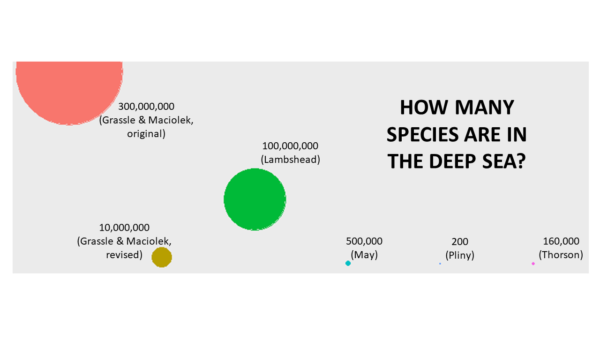
Grassle and Maciolek did some impressive math and ended up calculating that they were finding one new species per square kilometer they sampled. Let’s break that down. One square kilometer is equal to a little more than one-third of a square mile. So, they are basically finding three new species in each one-mile-square block of mud they are sampling. This means if they were to sample an area the size of New York City, they would find around 782 new species, and if they were to sample an area the size of London, they would find about 1,572 new species. These new species add up fast – you see, there are 300,000,000 square kilometers (115,830,647 square miles – almost 30 Europes or 431 Texases) of mud deeper than 1000 m in the ocean. The end result of all this is a conclusion of 300,000,000 species living in the mud at the bottom of the deep ocean. This is not counting swimming things! That’s a heck of a larger estimate than the 176 species estimate of centuries ago.
.It turns out that this calculation of Grassle and Maciolek was probably a bit of an overestimation. They realized that much of the ocean is oligotrophic, or not very nutrient-rich and therefore not very productive. This would mean that in many areas of the ocean, the rate of new species added per square kilometer is probably much less than what they found in their sampling area. So, they ended up conservatively estimating the true number at more like 10,000,000 species in the mud. This is still a huge amount of diversity in the deep sea.
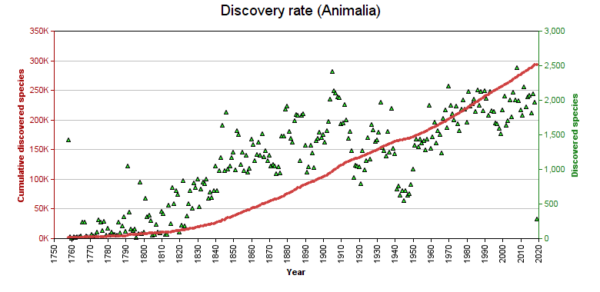
Grassle and Maciolek’s 10 million species hypothesis sparked quite the controversy, with biologists from many sub-disciplines quickly arguing for or against the high number. Isopod biologists Poore and Wilson said they had seen even more diversity just among isopods in their samples than the average number of species per 100 samples that Grassle and Maciolek had used in their calculations. This, they argued, must mean there are even more than 10 million species! In 1971, though, Thorson argued that there were only 160,000 species in the oceans across all depths- so far less than 10 million could be in the deep sea. In 1992, May argued that only 500,000 species would be possible in the deep sea. Lambshead in 1993 reminded everyone that there are a boatload of nematode worms and other animals (collectively called meiofauna) that live in the mud that were too small to be sampled by the gear Grassle and Maciolek used. This, Lambshead argued, could mean a total of 100,000,000 marine species. Consensus just could not be reached.
Here’s the problem, though. It is a hard question to answer. Each person who has attempted to answer this question was doing the best with the data that they had at the time (except Pliny- that guy was just an idiot okay). However, species diversity and especially how many species you discover in each new deep-sea “block” can vary considerably at different depths, regions, and oceans. Grassle and Maciolek’s encoutering 3 new species per block was based on data from the North Atlantic. Does 3 new species “rule” also apply to other parts of the Atlantic or to the Pacific? So without massive amounts of data, it is likely we will be kept guessing for a few more years to come. So, I can’t tell you exactly how many species are in the deep sea, but I can tell you that we currently have 409,543 named species in the ocean (World Register of Marine Species, accessed 03/18/2019). The best part is that we are getting better and better at discovering new species, and hopefully in years to come we will be much better equipped to answer this question realistically.
Cover photo credit to Monterey Bay Aquarium Research Institute (MBARI).

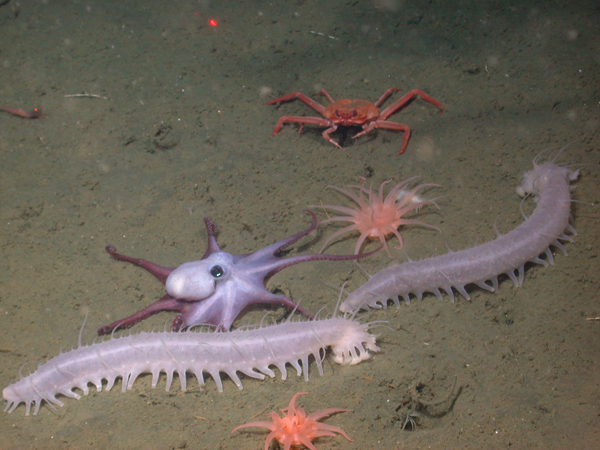
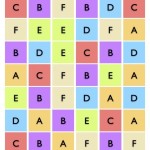

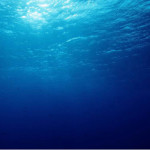
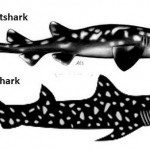

Nice notes on old ideas about deep species diversity. Keep up the great work.
Other worthwhile reading on the topic can be found in writings and accounts of public lectures given by participants of the Challenger Expedition. Unfortunately, it’s hard to find the references. Basically, the Challenger Expedition concluded that deep fauna is highly diverse. So, when and how did the general view that the diversity is low enter the discussion?
Murray, J. 1985. A summary of the scientific results obtained at the soundings, dredging, and trawling stations of the HMS Challenger. Challenger Report, Summary of Research 2:797-1608. Murray is quite specific in stating at while numbers decrease with depth, the variety of taxa increases and exceeds that found in shallow trawl samples.
Note, this is not one of the Report Series. It is a separate 2 volume publication.
The Voyage of H.M.S. “Challenger.” A Summary of the Scientific Results. (With Appendices). Two Parts. (London: Eyre and Spottiswoode, 1895.)
Potentially easier to find if you can locate old volumes of Nature are:
Moseley H.N. 1880 had pretty much already said the same in a series of lectures. Nature 21 (545) :p543-549, 21 (546) p569-573, 21 (547) p591-593.
The same for Jeffreys, J.G. 1881. Deep-sea exploration. Nature 23, (587) p23:300-301, 23 (588) p324-326.